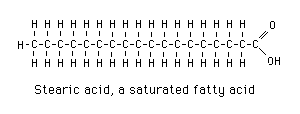Saturated fatty acids (SFAs)1 have been associated by the medical profession with increased risk of cardiovascular disease for several decades now. Recommendations to avert this outcome have included reducing the amount of SFAs in the diet. This could include cutting out red meats, and substituting low-fat dairy products for full-fat ones, as well as avoiding some industrially modified lipids. The action of any single nutrient in the body is complex. The research results on SFAs have been inconsistent and subject to intense controversy. However, a prudent public health diet strategy should probably recommend moderation in SFA consumption, as with any other dietary constituent.
The exact mechanism by which SFAs can affect cardiovascular health is still under study. However, research connects high dietary intake of SFAs to increased blood levels of Low Density Lipoproteins (LDLs) (Wang, Folsom, & Eckfeldt, 2003). These LDLs, in turn, are considered to be associated with higher incidence of atherosclerosis, or deposition of plaques of lipids and white blood cells on the arterial walls.
These plaques make the blood vessels narrower and less resilient. They also sometimes break loose to travel elsewhere in the body and block important blood vessels leading to the heart or to the brain. This can lead to what is commonly termed a heart attack or as stroke.
The action of these fatty acids in the body has been under continuing study. These are elements of food that primarily provide concentrated energy (calories). Additionally, and importantly, SFAs may occur in foods that provide nutrients such as high quality protein, iron, and vitamins A and D. The ways that fats are metabolized and the impact on various body systems are complex. For example, the metabolism and mobilization of fats can be affected by the individual’s exercise level. The amount of lipid circulating in the blood may be affected by the amount of stress the individual is experiencing, due to the lipid mobilizing effect of increased levels of cortisol.
Saturated fatty acids in red meat fat, and butterfat, are often largely solid at room temperature. Some oils or lipids that are liquid at room temperature are saturated industrially by increasing their constituent proportion of saturated fatty. This is called hydrogenation. Some unsaturated fats can be transformed into trans-fats, an isometric variant, during industrial food processing. Domesticated animal fat SFAs, as well as those from industrially processed fats are more common in the developed world, reflecting both wealth and the lure of convenience.
In recent decades, in spite of decreases in many other causes of mortality, cardiovascular disease has increased. Researchers associate this with the diet of the industrialized world and dramatic increases in consumption of processed foods (Astrup, et al., 2011).
Research suggests that replacement of SFAs with unsaturated fats is modestly helpful (Torrejón & Uauy, 2011), perhaps resulting in a 2-3% decrease in cardiac events (Astrup, et al., 2011). These results have prompted advice to avoid red meat, butter, whole fat cheeses, and hydrogenated oils, and to limit SFAs to 1% of energy intake (Torrejón & Uauy, 2011). The avoidance of trans-fats (more common in processed foods), is also recommended, although of uncertain efficacy (Woodside, McKinley, & Young, 2008).
Replacing SFAs with carbohydrates seems to be less effective at reducing the incidence of heart disease. This may reflect different action of different carbohydrates (Astrup, et al., 2011).2 Thus, control of SFAs may be a better strategy.
Individual diet is stunningly complex, and documenting it over the decades required to connect a single dietary constituent to disease incidence is logistically challenging. Diet is even harder to alter. However, the threat of cardiovascular disease justifies continued research attention and the use of any public health strategies that control SFAs to moderate levels in the diet.3
Reference List
Astrup, A., Dyerberg, J., Elwood, P., Hermansen, K., Hu, F. B., Jakobsen, M.,… Willett, W. (2011). The role of reducing intakes of saturated fat in the prevention of cardiovascular disease: Where does the evidence stand in 2010? American Journal of Clinical Nutrition, 93(4), 684-8. Web.
Baggot, J. (1998). Fatty Acid Synthesis and Classification. Web.
Centers for Disease Control and Prevention. (2012). Saturated Fat. Web.
The AOCS Lipid Library. (2013). FATTY ACIDS: STRAIGHT-CHAIN SATURATED. Web.
Torrejón, C., & Uauy, R. (2011). Quality of fat intake, atherosclerosis and coronary disease: effects of saturated and trans fatty acids]. Review of Medicine Chile, 139(7), 924-31. Web.
Wang, l., Folsom, A. R., & Eckfeldt, J. A. (2003). Plasma fatty acid composition and incidence of coronary heart disease in middle aged adults: The Atherosclerosis Risk in Communities (ARIC) Study. Nutrition, Metabolism & Cardiovascular Diseases, 13( 5), 256-266. Web.
Woodside, J. V., McKinley, M. C., & Young, I. S. (2008). Saturated and trans fatty acids and coronary heart disease. Current Atherosclerosis Reports, 10(6), 460-6. Web.
Footnotes
- Saturated fatty acids are lipids, or long chain hydrocarbons, with a particular structure. In carbon-containing molecules, the carbon atoms offer 4 places for other atoms to connect to them. (The AOCS Lipid Library, 2013) Alternatively the carbon atoms can bond to each other with double bonds. In saturated fatty acids, rather than having any double atomic bonds between the carbon atoms, the available spots for bonds have all been taken by hydrogen atoms (Centers for Disease Control and Prevention, 2012). This results in molecules that remain solid at room temperature. This differs from lipids that have one or more double carbon bonds (The AOCS Lipid Library, 2013). A typical saturated fatty acid would be stearic acid, whose structure is shown below:

- White sugar and brown rice, for example, both contain carbohydrates but are clearly quite distinct from one another in their impact on blood sugar elevation, speed of elimination, and doubtless, other processes.
- This could include the public health promotion of lower fat dairy products. These can be a convenient way to reduce SFA intake without major dietary changes that can be difficult for people to tolerate.